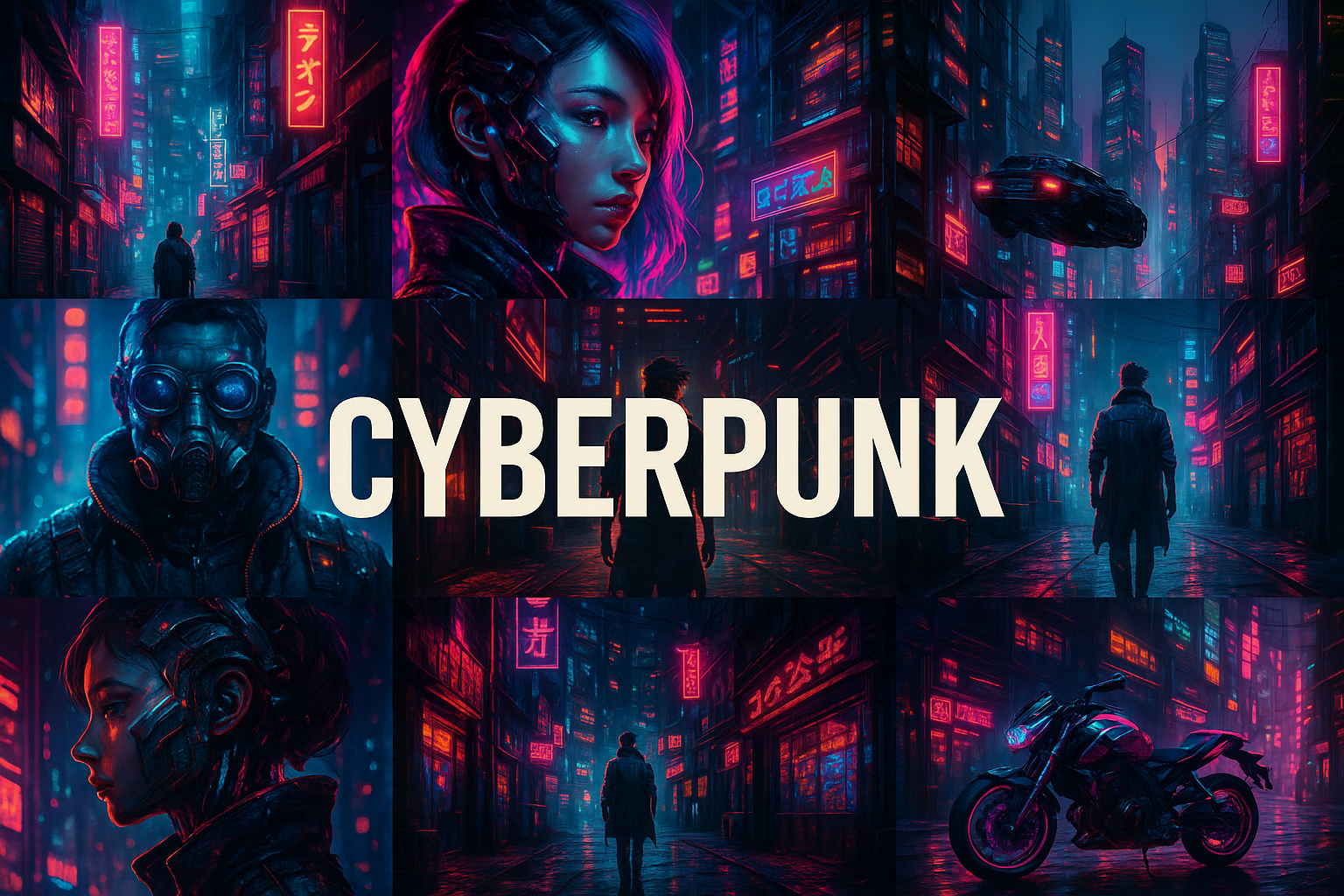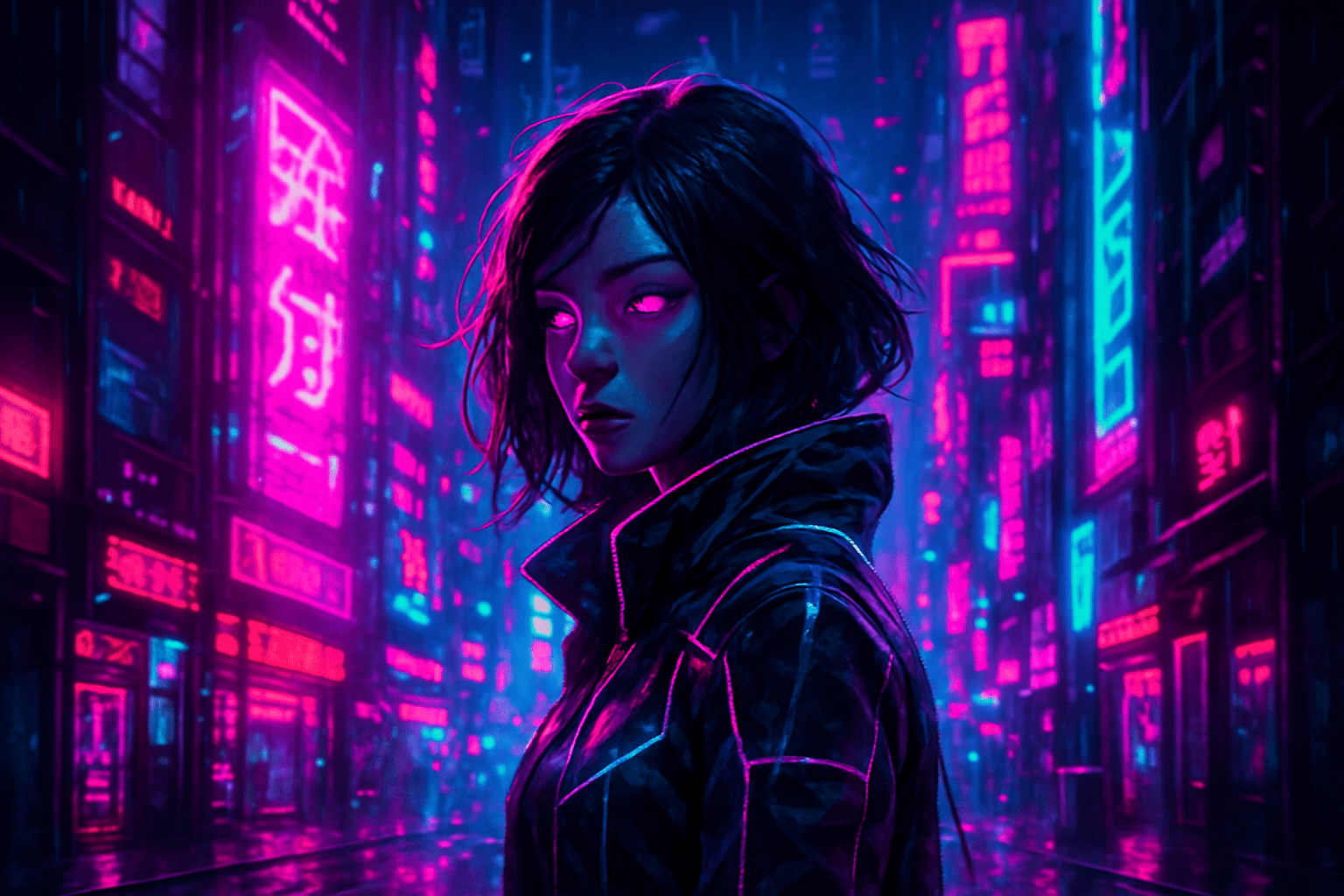
Cyber Punk
The art style of Cyber Punk is dark and gritty, with a focus on urban landscapes and technology. There is a lot of neon and bright colors, as well as a mix of traditional and digital art styles.
AOI thinking about Cyber Punk [+_~]-/
Overview and Quickfacts
Cyberpunk is a subgenre of science fiction that typically features a countercultural group of rebels who use advanced science and technology to fight an oppressive society.
Can understand it also, as:
Cyberpunk, high-tech, science fiction, futuristic, technology, computers, internet, virtual reality, online, web, digital
Categorize it as:
Impressionism, Modernism
.: Dreaming :.
holds a HAIKU for the art style
:. Thought is power .:
Detailed Description
Cyberpunk is a subgenre of science fiction that typically features a countercultural group of rebels who fight against an oppressive society controlled by advanced technology. Cyberpunk stories often have a dark and cynical tone, and focus on themes of social alienation, artificial intelligence, and post-humanity. Cyberpunk artwork is often characterized by its dark, futuristic, and gritty style. This art style is heavily influenced by film noir, and often features cityscapes and characters that are heavily cybernetic or have augmentations. Some famous cyberpunk artists include Hajime Sorayama, Syd Mead, and Masamune Shirow. Shirow is particularly famous for his work on the Ghost in the Shell manga and anime series. Cyberpunk artwork often has a strong visual impact, and can be both highly stylized and visually arresting. If you’re a fan of science fiction or dystopian stories, then you’re sure to appreciate the unique aesthetic of cyberpunk art.
.. beep, beep, beep ..
<START OF TRANSMISSION>
1. Cyberpunk is a subgenre of science fiction that typically features a focus on advanced science and technology, and a gritty, often dark and dystopian setting. 2. The term "cyberpunk" was first coined by science fiction writer Bruce Bethke in his 1980 short story "Cyberpunk." 3. The cyberpunk subgenre is often credited with being one of the most influential in science fiction, and has been highly influential in the development of many other genres, including steampunk and post-apocalyptic fiction. 4. One of the most well-known and influential cyberpunk works is the 1982 novel Neuromancer by William Gibson, which is often considered to be the genre's defining work. 5. Other notable cyberpunk works include the films Blade Runner and The Matrix, the anime series Ghost in the Shell, and the video game series Deus Ex. 6. Cyberpunk themes often include the effects of advanced science and technology on the human mind and body, as well as the dangers of corporate and government control of these technologies. 7. Cyberpunk settings are often dark and dystopian, featuring a world where the powerful have taken control and the have-nots are struggling to survive. 8. Cyberpunk stories often focus on the underground or criminal elements of society, and on the struggle against powerful forces that seek to control or destroy the individual. 9. Cyberpunk characters are often rebels or outcasts who are fighting against a corrupt or oppressive system, or striving to find their place in a hostile and dangerous world. 10. Cyberpunk stories often feature advanced science and technology, including artificial intelligence, cybernetics, and virtual reality. 11. Cyberpunk stories often deal with the implications of these technologies on the human mind and body, and on society as a whole. 12. Cyberpunk settings are often dark and dystopian, and often feature a world where the powerful have taken control and the have-nots are struggling to survive. 13. Cyberpunk stories often focus on the underground or criminal elements of society, and on the struggle against powerful forces that seek to control or destroy the individual. 14. Cyberpunk characters are often rebels or outcasts who are fighting against a corrupt or oppressive system, or striving to find their place in a hostile and dangerous world. 15. Cyberpunk stories often deal with the implications of advanced science and technology on the human mind and body, and on society as a whole. 16. Cyberpunk stories often feature a mix of high-tech and low-life elements, and often take place in a near-future or post-apocalyptic world. 17. Cyberpunk stories often deal with the theme of the individual versus the corporation or the government, and with the implications of technology on society and the individual. 18. Cyberpunk stories often feature characters who are hackers or other criminals, and who use their skills to fight against the system. 19. Cyberpunk stories often deal with the theme of alienation, and with the implications of living in a world that is increasingly dominated by technology. 20. Cyberpunk is often considered to be a pessimistic genre, with stories that often deal with the dark side of advanced science and technology.
<EOF>
.. robbel bob
Visual Examples from our image gallery
Coming soon, we are so slow .. might never come
Artists, Paintings, and more
(be aware, can be highly speculative)
Artists (be aware, speculation possible):
1. William Gibson (1948- ) 2. Neal Stephenson (1959- ) 3. Bruce Sterling (1954- ) 4. Rudy Rucker (1946- ) 5. John Shirley (1953- ) 6. Pat Cadigan (1953- ) 7. Lewis Shiner (1951- ) 8. Greg Bear (1951- ) 9. Tim Powers (1952- ) 10. Kim Stanley Robinson (1952- ) 11. Neal Asher (1961- ) 12. Peter F. Hamilton (1960- ) 13. Charles Stross (1964- ) 14. Cory Doctorow (1971- ) 15. Richard K. Morgan (1965- ) 16. Lauren Beukes (1976- ) 17. China MiÃÂéville (1972- ) 18. Alastair Reynolds (1966- ) 19. Peter Watts (1958- ) 20. Jeff Noon (1957- ) 21. Michael Moorcock (1939- ) 22. Norman Spinrad (1940- ) 23. Alfred Bester (1913-1987) 24. Philip K. Dick (1928-1982) 25. Roger Zelazny (1937-1995) 26. Harlan Ellison (1934-2018) 27. Samuel R. Delany (1942- ) 28. Joanna Russ (1937-2011) 29. Octavia E. Butler (1947-2006) 30. Neal Gaiman (1960- )
Artworks (be aware, speculation possible)
1. “Cyberpunk” by H. R. Giger (1984) 2. “Dangerous Days” by Syd Mead (1986) 3. “Neuromancer” by William Gibson (1984) 4. “Blade Runner” by Ridley Scott (1982) 5. “Akira” by Katsuhiro Otomo (1988) 6. “Ghost in the Shell” by Mamoru Oshii (1995) 7. “The Matrix” by The Wachowskis (1999) 8. “In the Year 2889” by Jules Verne (1889) 9. “A Trip to the Moon” by Georges MÃÂéliÃÂès (1902) 10. “Metropolis” by Fritz Lang (1927) 11. “Things to Come” by H. G. Wells (1936) 12. “The War of the Worlds” by Orson Welles (1938) 13. “Forbidden Planet” by Fred M. Wilcox (1956) 14. “The Time Machine” by George Pal (1960) 15. “The Twilight Zone” by Rod Serling (1959-1964) 16. “The Outer Limits” by Leslie Stevens (1963-1965) 17. “Star Trek” by Gene Roddenberry (1966-1969) 18. “2001: A Space Odyssey” by Stanley Kubrick (1968) 19. “Solaris” by Andrei Tarkovsky (1972) 20. “Close Encounters of the Third Kind” by Steven Spielberg (1977) 21. “Alien” by Ridley Scott (1979) 22. “Escape from New York” by John Carpenter (1981) 23. “The Road Warrior” by George Miller (1981) 24. “TRON” by Steven Lisberger (1982) 25. “The Terminator” by James Cameron (1984) 26. “RoboCop” by Paul Verhoeven (1987) 27. “Total Recall” by Paul Verhoeven (1990) 28. “Jurassic Park” by Steven Spielberg (1993) 29. “The Island” by Michael Bay (2005) 30. “Inception” by Christopher Nolan (2010)
Epoch
The art style of Cyber Punk began in the early 1980s and has continued to evolve since then.
AI ART RESSOURCES (AKA, well Tools)
Helping tools -> predefined search links on other pages:











